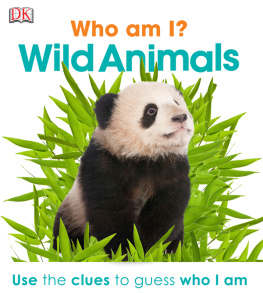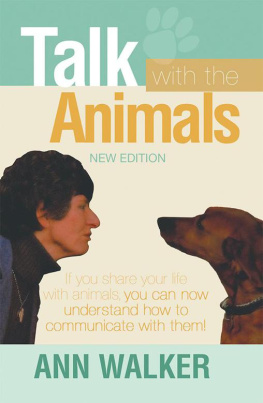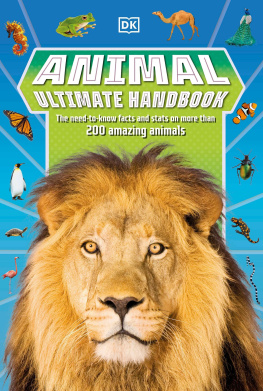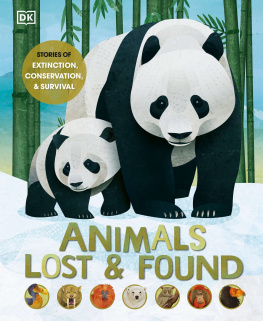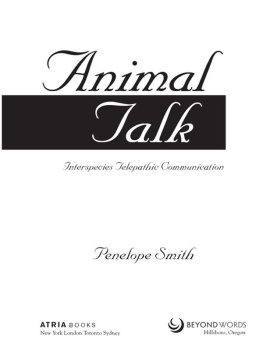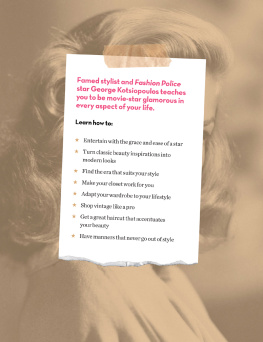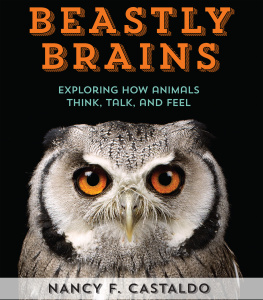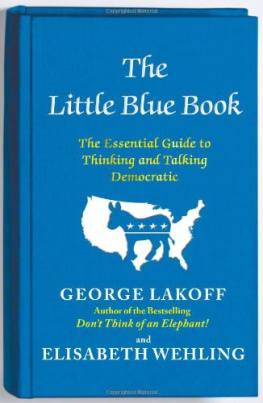George - How to Talk to Your Animals
Here you can read online George - How to Talk to Your Animals full text of the book (entire story) in english for free. Download pdf and epub, get meaning, cover and reviews about this ebook. year: 2011, publisher: Open Road Media, genre: Detective and thriller. Description of the work, (preface) as well as reviews are available. Best literature library LitArk.com created for fans of good reading and offers a wide selection of genres:
Romance novel
Science fiction
Adventure
Detective
Science
History
Home and family
Prose
Art
Politics
Computer
Non-fiction
Religion
Business
Children
Humor
Choose a favorite category and find really read worthwhile books. Enjoy immersion in the world of imagination, feel the emotions of the characters or learn something new for yourself, make an fascinating discovery.

- Book:How to Talk to Your Animals
- Author:
- Publisher:Open Road Media
- Genre:
- Year:2011
- Rating:4 / 5
- Favourites:Add to favourites
- Your mark:
- 80
- 1
- 2
- 3
- 4
- 5
How to Talk to Your Animals: summary, description and annotation
We offer to read an annotation, description, summary or preface (depends on what the author of the book "How to Talk to Your Animals" wrote himself). If you haven't found the necessary information about the book — write in the comments, we will try to find it.
How to Talk to Your Animals — read online for free the complete book (whole text) full work
Below is the text of the book, divided by pages. System saving the place of the last page read, allows you to conveniently read the book "How to Talk to Your Animals" online for free, without having to search again every time where you left off. Put a bookmark, and you can go to the page where you finished reading at any time.
Font size:
Interval:
Bookmark:

To Rebecca Jean Pittinger
A CHILDHOOD HERO of mine was a long-shanked blacksmith with the body of a badger and the eyes of a deer who could talk to the animals. Will Cramer was known as the man who knows what the animals say. Chickadees clustered around his door; stray dogs came to the gate of his clapboard home as if they had heard through some mysterious grapevine that he would take care of them. Will lived in the valley of the Yellow Breeches Creek in Pennsylvania, down the road from my grandfathers house where my parents, brothers, and I spent our summers. Evenings, my brothers and I often sat on the porch railing of the country store and listened to the farmers talk about crops, the weather, and, now and then, about Will Cramer. Will listened to a cow bawl today and told Jim Hucklefinger that she wanted to be moved to another stanchion. On another occasion Will heard a dog whine and told his owner, Your hound wants his collar loosened.
The farmers did not quite believe Will, but did not discredit him either. They were all aware that some kind of communication went on between themselves and their chickens, cows, pigs, horses, cats, and dogs. If it wasnt exactly talk, it was something akin to it. When the dog barked, they got up and went to see who was approaching the house, and when the cow bawled, they milked her. Communication is, after all, an action by one individual that alters the behavior of another, no matter how humble the creature or how strange the language. A toad excretes a noxious fluid when picked up by bird, beast, or man, that says quite unneatly, Drop me. Most do.
Will Cramer not only altered his own behavior when the animals spoke to him, he altered theirs by speaking to them in their own language. He asked his dog Nick, who was standing at ease beside him one day, to play by getting down on all fours and spanking the ground with outstretched arms, as dogs do when they are sparking another dog to rough and tumble. He told the cow he wanted her in the meadow by uttering bovine sounds to attract her attention, then stepping in front and walking. In cow language, the animal in the lead is saying, Follow me.
Anyone watching Will with animals would believe he had some gift not given to other persons, but he told me the year before he died that he just watched what the animals were doing or listened to their vocalizations, then observed what happened next. In other words, Will studied cause and effect, which is how all animal communication functions. A wolf leaves a scent of its presence and social status in its urine at the edge of its territory, and another wolf reads who it is with thoughtful inhalations and either turns away or, recognizing a friend, comes on. Hello, we say to a person and wait to see the effect of our greeting before going on with the conversation or taking our leave.
Our remarkable communication systemour spoken language, with its infinite combinations of sounds strung together by rulesis so advanced, we believe, compared with nonhuman systems that most of us fail to recognize seemingly simpler dialogues. They are all around us: the cecropia moth calling in chemicals, the spider receiving and sending telegraph messages along a thread, the spreading tail of a peacock speaking of masculinity through a vision of beauty, the wolves keeping their space around them by howling in concert. The odors, poses, movements, displays, and the clicks, hisses, chirps, and bellows are communications. Animals, including us, speak in the four media of scent, touch, sight, and sound. Some messages use but one medium, some all four, but all media, all messages, are the self reaching out to be known by others.
Anyone with even the slightest acquaintance with animals recognizes a kittens mew as a plea and a dogs bark as a warning. But they are only the tip of the iceberg. Animal communication has turned out to be far more complex than we had guessed until recently.
1920 was a landmark year in our awakening to the true meaning of the prettiest of all animal sounds in nature. That year British businessman Elliot Howard published his discovery that a birds song is not the outburst of joy we in our innocence had supposed it to be, but a rather businesslike announcement specifically addressed to others of its kind. Birds sing to announce property lines, advertise for a mate, and proclaim ownership of a good habitat for the rearing and feeding of young.
Howard spent years wandering his estate, observing and charting the behavior of resident songbirds. Gradually his notes and diagrams took shape. A certain male bird was always in the same area, he sang from the same bushes and trees, and, no matter how long Howard pressed him, he never left that piece of land. Like himself, the bird had territory, and like himself, he defended it, not with words, laws, and guns, but with song. The seemingly pleasant little bird was threatening his neighbor with, Keep off my property. Once Howard recognized this, everyone saw itand with a deep sense of shock, not so much because birdsong was tough talk, but because it took so many millennia for intelligent mankind to recognize something so obvious.
The discovery of territorial behavior in birds hatched a host of scientific disciplines: ethology, sociobiology, animal behaviorism, cognitive ethologya potpourri of names for fields in which men and women have put aside the study of conventional physical zoology to observe the thinking, communications, and social behavior of nonhuman animals. Now six decades of their observations have caused a flip-flop in our thinking. We can no longer speak of dumb animals. Most natural scientists believe today that the birds and beasts are not automatons, performing by instinct without thought or feeling, but creatures of intelligence and sensitivity that communicate in many ingenious ways. Will Cramer was right: the animals do talk, not only to each other but to us if we listen.
Talk and listen are impoverished words to use to mean communication; perhaps our reliance on speech explains why we spent so long noticing so little animal palaver. For instance, the oldest, and still most fundamental, medium of communication is chemicals. We are aware of molecule messages as the very few tastes and relatively strong odors we can discern. We consciously use sweets and perfumes in courting. But thats nothing compared with the chemical languages we are not aware of. Every cell of our body is in constant communication through the chemicals called hormones and neurotransmitters. One cell emits molecules of insulin, and another, receiving the word, knows to take up sugar from the bloodstream. Chemical language is most likely all lifes mother tongue, for bacteria, from their position on the lowest rung of the phylogenetic ladder, speak in insulin and estrogen. Even plants talk chemically. The alder tree when attacked by insects sends out a chemical vapor that tells other nearby alders that insects are attacking. They respond by depleting their leaves of nutrients and loading them with insect-killing toxins. Bacteria speak through chemicals that keep them together where there is food and warmth and bring them together for rare matings. Scientists are only beginning to unravel chemical communication, but they are sure the lexicon includes the most essential distinction: self and other. Bacteria string along only with their own kind, each joining with others most like itself. On the other hand, a bacterium couples for sexual purposes only with an individual of its own kind that is not identical to itself. The first message might therefore be translated as I am I, an announcement of species and individual self. Trading such messages, some organisms can apparently gauge their relatedness.
Font size:
Interval:
Bookmark:
Similar books «How to Talk to Your Animals»
Look at similar books to How to Talk to Your Animals. We have selected literature similar in name and meaning in the hope of providing readers with more options to find new, interesting, not yet read works.
Discussion, reviews of the book How to Talk to Your Animals and just readers' own opinions. Leave your comments, write what you think about the work, its meaning or the main characters. Specify what exactly you liked and what you didn't like, and why you think so.








